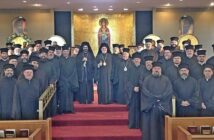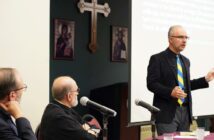Source: Frankly Speaking
by Frank Marangos D.Min., Ed.D.
“Leadership is much more an art, a belief, a condition of the heart, than a set of things to do. The visible signs of artful leadership are expressed, ultimately, in its practice.” – Max Depree
Award-winning actor and director, Clint Eastwood, set Twitter afire after conversing with an empty chair at the Republican National Convention. The 82-year old thespian used a wooden stool as a stage prop to conduct a controversial political interview with President Obama. While reaction to Eastwood’s “invisible leader” monologue provided pundits with plenty of political repartee, the Internet now includes anonymous postings from countless irritated employees who include images of empty chairs with the photos of their respective company leaders.
Presidential election politics aside, Eastwood’s empty chair parody provides a wonderful opportunity to examine the importance of leadership visibility. Leaders cannot effectively discharge their duties if the image of their influence is an empty chair. As effective leadership is not a solo proficiency, principals must vigilantly guard against appearing invisible to their respective employees and/or constituents!
One of the hallmarks of noble leadership is effective visibility. While empty chair leaders are characterized by excessive periods of invisibility, eminent leaders rarely abdicate the “seats” of their core responsibilities. They labor against abandoning the difficulties of their enterprise by faithfully shouldering the requirements of their position. While some may unfortunately kick, throw, and hide behind the symbolic chairs of their obligations, sagacious leaders chivalrously share the influence of their respective positions with appropriate selectivity.
Chairs are more than utility furniture. They are more than three or four pieces of wood nailed to a board. The chair has been used for thousands of years as an image of prestige and privilege. It’s symbolism survives today within the walls of universities, boardrooms and governments as positions bestowed upon important people who carry the honorable title of chairpersons. These “chairs” trace their lineage back (delete comma after chairs) to ancient Greek and Roman empires to show wealth, status, and power. For centuries monarchs encrusted their chairs with jewels and elaborate carvings. Thus, thrones were created to express imperial authority. In early American homes, only the head of the house sat in a chair that expressed his indisputable leadership. In time the executive leather office chair appeared to display the importance of the chief operating officer.
Strategic visibility is the antidote to the leadership syndrome of the empty chair. It allows leaders to inspire, connect, and understand what is in the hearts and minds of their employees. Visibility, however, is a risky obligation. Nonetheless, executives should avoid the safe solitude of their corner offices by choosing visibility as a way of communicating a most valuable message: “I care. I’m here. Talk to me. I’ll listen!”
The following five (5) habits of leadership visibility ensure the primary objectives of establishing valuable connections and inspiring dialogue.
- Impromptu Meetings. Visible leaders regularly attend departmental meetings, unannounced, without being on the agenda or appearing to be snooping. They unassumingly listen, ask questions, and/or invite employees or constituents to propose creative ideas and solutions.
- Hallway Dialogues. Visible leaders seek face-to-face conversation with individuals and small groups. They allow others to choose the topic of discussion and authentically care about the personal lives of their followers.
- Touch-Base Meetings. Visible leaders periodically invite individuals and teams to relaxed gatherings. They complement and proffer honest praise for hard work and organizational contributions. They publicly celebrate the success of others.
- Brown Bag Lunches. Visible leaders schedule informal lunches to get together with employees on a rotational basis. These meals build connections by encouraging conversations without a formal agenda. Lunches open to entire departments provide valuable opportunities for anyone to discuss a particular topic, answer questions, and ensure that all voices are heard.
The fifth and final tactic that leaders may utilize for effectively establishing productive visibility is a “Walk-Through,” or “Walk-About.” The “Walk-Through” is a strategic process developed by the Institute of Learning at the University of Pittsburgh. “Managing by Wandering Around” (MBWA), on the other hand, is a similar method designed by the best-selling author and management consultant, Tom Peters. Both techniques support a systemic focus on organizational learning, morale building, and process improvement.
Commonly referred to as a “technology of the obvious,” the MBWA is a leadership procedure that involves itinerant “wandering” through an organization’s buildings, hallways, lunchrooms, and offices. Formalized in recent years, such walk-through processes transcend traditional snooping tours conducted by supervisors. In the spirit of continuous organizational improvement, visible leaders embark on “Walk-Abouts” in an effort to authentically learn, engage, inspire, and be inspired by their constituents.
General MacArthur was a firm believer in leadership visibility and the value of its accompanying “walk-through” vulnerabilities. In early 1942, understanding the impact that a commander’s presence has on his troops, MacArthur moved his headquarters to the island of Corregidor. He established his visibility “Topside,” a term the general used to describe the highest point on the small island. “I deem it advisable,” he boldly asserted, “to locate my headquarters as prominently as possible, notwithstanding exposure to enemy attack. It will be an evidence of assurance to these people suffering from deprivation, destruction, and despair.”
“Topside” visibility is a key part of being an effective leader. Such visibility, however, is not based on crafty public relations strategies but on a leader’s sincere desire to serve others and thereby influence overall organizational effectiveness and innovation. Visibility is, therefore, a double-edged sword. Leaders must be visible but not annoyingly self-centered. Kicking, throwing and/or arrogantly standing on chairs of positional status are gestures just as regretful as the voluntary retreat from difficult accountabilities. True visibility does not promote such hubris or evasion. On the contrary, the calculus of effective leadership is the sum of visible vulnerability multiplied by the untiring efforts of invisible ego.
Leadership involves interacting and influencing people, bringing forward the best of authenticity to the challenges and situations at hand. In contrast, poor visibility from leaders within an organization leads to negative perceptions that effect employee morale, performance, behavior, trust and communication. Regardless of profit or philanthropic category, the damaging effect of empty chair leadership manifests itself both within and without all entities. Religious institutions, however, have a greater responsibility to faithfully provide the venerable chairs of humility and selfless love in service to society.
“Topside” leadership is about modeling such noble behavior. It is the result of the visible influence of invisible personalities. It conveys the notion of leading and mentoring through humble example. At least once in their careers, every leader will inevitably face the dilemma of having to choose between this true purpose of leadership (empowering others), and the ego of showmanship (getting credit). The struggle between humility and hubris is one that all leaders must strive to overcome. The art of visible leadership rests on the knack of shifting the focus away from oneself while simultaneously maintaining an authentic modesty that is not concerned with who gets the credit or whose name goes at the top of the list. It is the kind of self-effacement that uses the words we and team and us!
Leadership style has a direct effect on an organization’s outward expressions. While empty chair leaders abstain from regularly wrestling with issues outside their institutional control, visible leaders seek out opportunities for cultural engagements. Empty chair leaders are characterized by a hierarchical style whose “open door” policies only extend to the political and powerful elites. Visible “topside” leaders, on the other hand, celebrate opportunities to meet with even the least influential of their employees or constituents. Empty chair leaders rarely dine in company lunchrooms but regulate their associations with only the most like-minded members of their leadership caste. Sadly, they also refrain from all forms of personal risk by firmly ensconcing themselves behind layers of administrative ramparts!
By avoiding those of lower rank and the responsibility of making difficult decisions, empty chair leaders create a dangerous Laissez-faire environment. Apart from employee cynicism and mistrust, organizations that lack the hands-on guidance of visible leaders suffer from low morale that affects productivity. Without relation-based direction, the very meaning of work gets lost, employees stop caring, and performance declines to ineffective levels. In order to cope, employees, constituents, and followers develop “silo mentalities” that thrive on deception, knowledge hoarding, and unhealthy completion.
Servanthood is the visible remedy for such ill-fated circumstances. It is the venerable chair that should never be abdicated as it indicates the true measure of a leader’s influence! Without mentors who desire to authentically model lofty moral standards, organizations lack the cultural health to help guide them through ethical disparities. Without the visible unifying force of such aspirational leaders, organizational vision is blurred and the mission is jeopardized!
In the end, Eastwood’s convention parody elicits an alternative lampoon. Two years after his assassination, Congress formed the Lincoln Monument Association tasked with the responsibility to construct an appropriate memorial dedicated to Abraham Lincoln. Construction started in 1914. The design by New York architect Henry Bacon was based on a Greek temple with 36 Doric columns. Inside the tall marble temple, designed by Daniel Chester French, is a large sculpture of Abraham Lincoln seated in a chair 19’ tall.
Now imagine, a televised line of contemporary religious, business and political leaders all waiting their turn to stand before the mammoth marble chair and respond to Lincoln’s – not Eastwood’s – interrogation of their leadership style. How would contemporary leaders respond to such a societal questioning by the 16th president of the United States?
Now that would be a routine worth Tweeting about!




2 Comments
Considering that Father Marangos just simply disappeared from his parish, as DEAN of the New York Cathedral, undoubtedly the most prestigious assignment in the GOA, isn’t this a bit of the pot calling the kettle black? Obviously he makes great points about what is wrong with our hierarchs. I would agree with every one of his observations. However, I would suggest that perhaps his recent action in simply disappearing and leaving his “chair” empty was not the best way to handle his obvious objections to the difficulties he found in his position and in the leadership inadequacies we find in today’s hierarchy. Well written, but more than puzzling, considering the source.
Let me see if I understand the comment: So, “he makes great points about what is wrong with our hierarchs” and the commentator “agree(s) with every one of his observations” but she finds fault with the manner in which Father left “undoubtedly the most prestigious assignment in the GOA” to take a position in the private sector where his considerable talents can be utilized outside of the reach of the “difficulties .. in the the leadership inadequacies we find in today’s hierarchy”?
Rather than shooting the messenger who has delivered an important message, wouldn’t the better comment be: “What can be done to improve the GOA’s leadership so that the best and brightest (Clergy and Lay) do not continue to leave?”